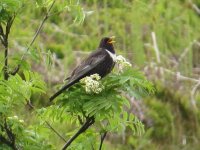Of those scarce migrants, I would only include as 'native' ie ordinarily seen with regularity in Britain either as residents, summer or winter visitors or passage migrants:-
Yellow-browed Warbler - 4,500 (1,984)
Cory's Shearwater - 1,462 (659)
Wryneck- 453 (425)
Siberian Chiffchaff - 434 (248)
Caspian Gull - 362 (2014-16 average)
Grey Phalarope - 347 (328)
Great Grey Shrike - 270 (266)
Cattle Egret - 192 (59)
Red-breasted Flycatcher - 174 (142)
Little Bunting - 169 (73)
Red-backed Shrike - 146 (200)
Pallas's Leaf Warbler - 138 (54)
Barred Warbler - 136 (251)
Hoopoe - 125 (127)
Richard's Pipit - 119 (117)
Sabine's Gull - 112 (186)
Bluethroat - 97 (68)
Common Rosefinch - 96 (171)
Pectoral Sandpiper - 95 (153)
Icterine Warbler - 76 (89)
Glossy Ibis - 72 (82)
Temminck's Stint - 71 (104)
European Serin - 58 (39)
Golden Oriole - 50 (85)
Red-necked Phalarope - 32 (42)
White-billed Diver - 26 (25)
Rough-legged Buzzard - 25 (71)
Marsh Warbler - 25 (46)
Spotted Crake - 22 (24)
Ring-necked Duck - 17 (21)
Surf Scoter - 15 (15)
Some of these appear surprisingly scarce presumably as a result of excluding breeding birds or returning birds. Additionally, of course, Siberian Chiffchaff and Grey-headed Wagtail are subspecies.
All the best
I think that list, you would maybe see 6 in a year, if you were lucky, without dipping into the "RBA, dropping everything, long distance trips" category.
That's the trouble with rare and scarce birds.. they are rare and scarce!!








